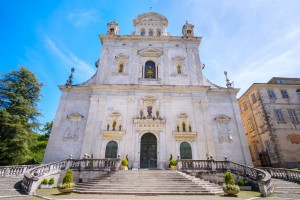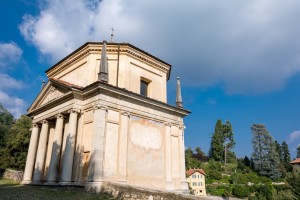The Late Middle Ages saw a steady decline of pilgrimages to the Holy Land. Italian believers started looking for other places and destinations. Numerous chapels, basilicas and other religious buildings in larger cities aside, a series of nine chapel facilities and pilgrimage churches was built at lakes and on mountains, mostly during the late 16th and the 17th century. The Sacri Monti are dedicated to various aspects of Christianity whilst being perfectly embedded into the stunning scenery. These nine facilities in Northern Italy – eight of which are in Piedmont with another one located in Lombardy – were declared UNESCO World Heritage Site in 2003. Time for a look at these marvels.
Sacro Monte di Varallo

©Bigstock.com/Luca Lorenzelli
The symbolisation of the Holy Land, which had become inaccessible for many pilgrims, commenced in 1491 by laying the foundation for Varallo, the 45-part place of pilgrimage, completed after around 150 years. Comparatively unknown painters and architects worked on a plethora of stunning paintings and sculptures gracing the numerous chapels. 600 life-sized figures made of wood and terracotta and another 4,000 painted figures are distributed across the various buildings. Don’t miss out on a trip to the grand pilgrimage church dedicated to the Virgin Mary.
Sacro Monte di Crea
The chapels on the hills of Basso Monferrato are a bit older originally featuring depictions from the life of the Virgin Mary. During the Sacri Monti endeavours, mostly prompted by the Franciscan Costantino Massino, the existing structures at this site of pilgrimage attributed to Saint Eusebius of Vercelli were changed repeatedly from 1581 onward. Partial destruction in 1820 led to extensive restoration works. As a result, you now get to look forward to an exciting mix of different styles on your path to the large pilgrimage church with the Paradise Chapel as the main highlight. Walking through the protected nature park of Sacro Monte di Crea, you get to see plant species that have mostly disappeared from the wild.
Sacro Monte d’Orta
The pilgrimage route above Orta San Giulio in the province of Novara features 20 chapels all dedicated to a single saint. Your walk unearths a plethora of scenes from the life of Saint Francis of Assisi ranging from his birth to the calling to his works, death and the miracle of the saint. Original plans even consisted of 36 chapels, sadly met with organisational issues – no problem, though, as the existing buildings are a breathtaking charm by themselves. Meet pilgrims from all over the world along this spiralled path. They are magically attracted to the church on the summit of the Sacro Monte. Originally dating back to the 11th century and consecrated to Saint Nicholas, the re-design inspired by the lower Basilica of Saint Francis of Assisi had Saint Francis “rise” to the role of co-patron saint.
Sacro Monte di Varese

©Bigstock.com/disto89
Believers attributed the victory in the Battle of Lepanto in 1571 to their intercessions. Initiated by the Capuchin monk Giovanni Battista Aguggiari from Monza, this sacred mountain was founded in 1604 and dedicated to the mysteries of the rosary. The former medieval ritual place turned convent became a pilgrimage church dedicated to the Virgin Mary with a special wall-framed road leading up the hill. Along the way you come across 14 chapels with Palladio-style sculptures. Subtle variations make each and every building unique and worth visiting.
Sacro Monte d’Oropa
Pilgrims were already familiar with Biella, as the Oropa district had been home to various chapels and other religious sites. However, they were renewed, converted and complemented by additional buildings starting in 1620. 19 chapels now line the pilgrimage route, twelve of which – arranged almost parallelly – are dedicated to the life of the Virgin Mary. The other seven deal with various other topics of Christianity. Contrary to comparable sites, Sacro Monte d’Oropa relies on distinctly alpine features with slab coverings, thereby connecting the classic religious style of its time with local flair – a truly interesting experience.
Sacro Monte d’Ossuccio
Similar to Varese, the site of pilgrimage in Ossuccio at the western shore of Lake Como is devoted to depictions of the mysteries of the rosary. 230 terracotta statues in 14 chapels, all built between 1635 and 1710, express the joyful, painful and glorious mysteries. The upward path extends from the annunciation to the temple to the crucifixion and resurrection to Mary’s assumption to heaven. Having arrived on the top, the Catholic pilgrimage church concludes the pilgrimage route as its 15th part. See the coronation of the Mother of God on the high altar, magnificently highlighted by light and shadow.
Sacro Monte di Ghiffa
According to legend, there had already been a chapel above Ghiffa at Lago Maggiore as early as the 4th century. A documented Romanesque oratory was established in the 12th and 13th century and constantly expanded due to a constant influx of pilgrims. It would take until the late 16th century before this site was turned into a Sacro Monte. Three chapels depicting biblical scenes, an arbour path with Stations of the Cross and the rather strictly vested pilgrimage church invite you to go on a foray through the history of the Bible. Additionally, there’s a special nature reserve around Sacro Monte di Ghiffa. It was carefully reforested over the last decades now inviting you to go on quiet, reflective walks.
Sacro Monte di Domodossola
Two Capuchins picked the hill Colle Mattarella above Domodosso as the perfect site for a place of pilgrimage in 1656. Ultimately, twelve chapels dedicated to Stations of the Cross and another one about the resurrection were built. The glorious depictions – some statuary, others as frescoes – accompany you on your summit hike where the octagonal pilgrimage church already awaits you. The associated park is at least as exciting as the Sacro Monte itself. Your walk leads you to the ruins of a castle destroyed by Swiss soldiers in 1415 and the amazing nature and wildlife of this special nature reserve.
Sacro Monte di Belmonte
The final Sacri Monti chapter took the longest to establish and to complete. An initiative of the devout Friar Minor Michelangelo da Montiglio led to the commencement of this project in 1712. It took over 100 years until its completion due to several disruptions. All chapels were built in set gaps to one another. Composition and endowment of the structures dedicated to the mysteries of the rosary are fairly uniform suggesting one single architect who remained anonymous. The sanctuary surrounded by lush, green vegetation already awaits you.
You don’t have to be a believer to fall under the spell of the breathtaking Sacri Monti. Nine highly different yet in some way seemingly unitary sites of pilgrimage invite you on a slightly different expedition of Northern Italy. Let yourself be amazed by sophisticated architecture, astonishing art and exciting natural beauty!